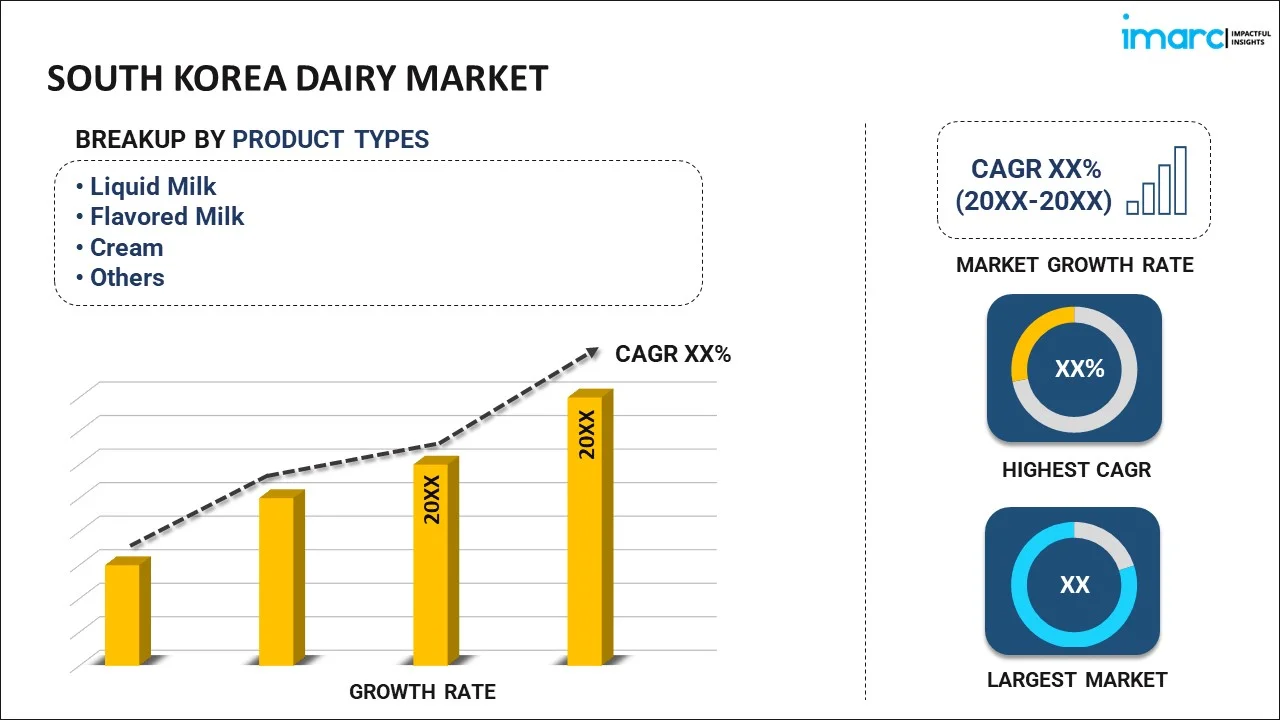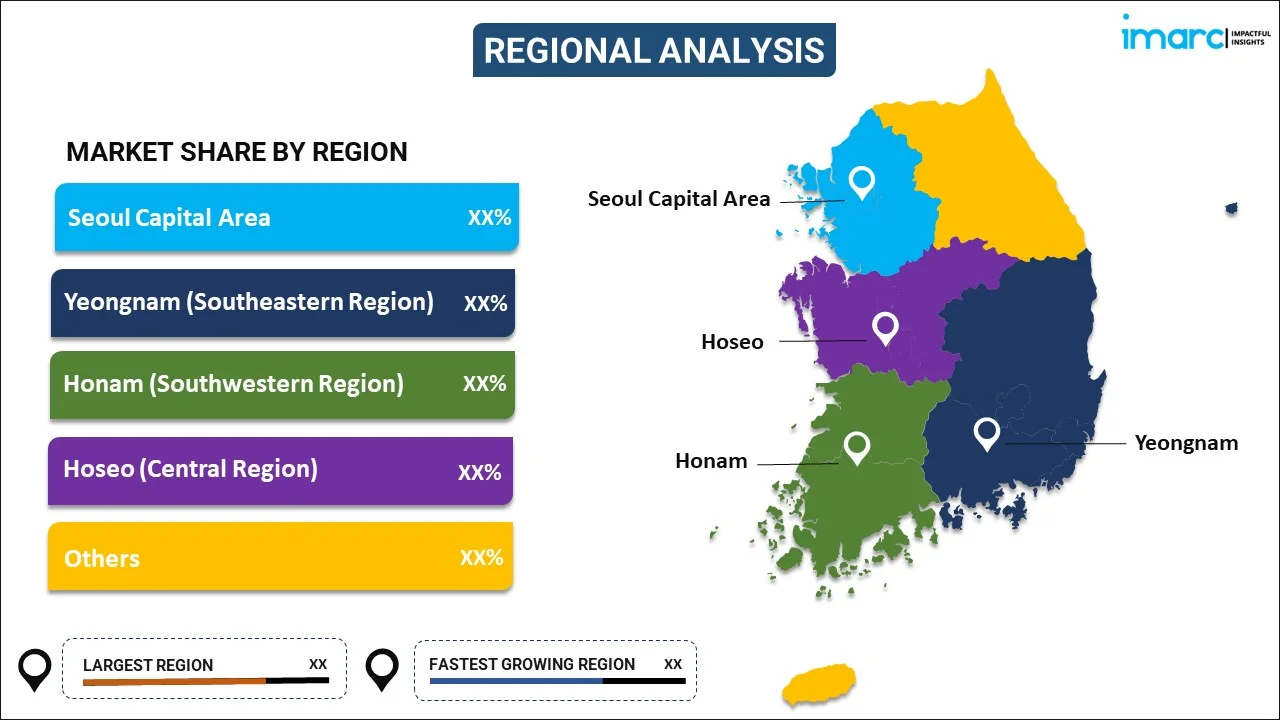
South Korea Dairy Market Report by Product Type (Liquid Milk, Flavored Milk, Cream, Butter, Cheese, Yoghurt, Ice Cream, Anhydrous Milk Fat (AMF), Skimmed Milk Powder (SMP), Whole Milk Powder (WMP), Whey Protein, Lactose Powder, Curd, Paneer), and Region 2025-2033
Market Overview:
South Korea dairy market size is projected to exhibit a growth rate (CAGR) of 4.09% during 2025-2033. The shifting dietary patterns, influenced by factors such as health awareness and dietary trends, which impact the demand for specific dairy products, is driving the market.
|
Report Attribute
|
Key Statistics
|
|---|---|
|
Base Year
|
2024 |
|
Forecast Years
|
2025-2033
|
|
Historical Years
|
2019-2024
|
| Market Growth Rate (2025-2033) | 4.09% |
Dairy, an integral part of human civilization for centuries, encompasses a vast array of products derived from milk. This diverse category includes staples like milk, cheese, butter, and yogurt, each holding a unique place in culinary traditions. As a rich source of essential nutrients such as calcium, protein, and vitamins, dairy plays a crucial role in supporting overall health and development. Beyond its nutritional significance, dairy products contribute to the cultural tapestry of societies, influencing culinary practices and preferences. The dairy industry, a complex network of farmers, processors, and distributors, has evolved significantly over the years with advancements in technology and sustainable practices. From traditional small-scale dairy farms to large-scale industrial production, the sector continues to adapt to meet the growing demands of the population. However, the industry also faces challenges, including environmental concerns, animal welfare considerations, and dietary trends favoring alternative options. Dairy remains a cornerstone of diets, economies, and cultural heritage, reflecting both tradition and innovation in the pursuit of nourishing communities.
South Korea Dairy Market Trends:
The dairy market in South Korea is propelled by various factors, interconnected in a complex web that shapes its dynamics. Firstly, the increasing regional population and rising disposable incomes have heightened the demand for dairy products. Consequently, this surge in demand acts as a catalyst, stimulating the dairy industry's growth. Additionally, shifting consumer preferences toward healthier and protein-rich diets further fuel the market's momentum. Moreover, technological advancements in dairy farming practices enhance production efficiency, contributing to market expansion. On the other hand, environmental concerns and ethical considerations have prompted a rise in demand for sustainable and ethically sourced dairy products, steering the market towards eco-friendly practices. Furthermore, globalization and regional trade agreements have facilitated the within-border movement of dairy products, creating a more interconnected and competitive market landscape. In conclusion, a delicate balance of demographic, economic, technological, and ethical factors intricately intertwines to drive the dynamics of the dairy market in South Korea.
South Korea Dairy Market Segmentation:
IMARC Group provides an analysis of the key trends in each segment of the market, along with forecasts at the country level for 2025-2033. Our report has categorized the market based on product type.
Product Type Insights:

- Liquid Milk
- Flavored Milk
- Cream
- Butter
- Cheese
- Yoghurt
- Ice Cream
- Anhydrous Milk Fat (AMF)
- Skimmed Milk Powder (SMP)
- Whole Milk Powder (WMP)
- Whey Protein
- Lactose Powder
- Curd
- Paneer
The report has provided a detailed breakup and analysis of the market based on the product type. This includes liquid milk, flavored milk, cream, butter, cheese, yoghurt, ice cream, anhydrous milk fat (AMF), skimmed milk powder (SMP), whole milk powder (WMP), whey protein, lactose powder, curd, and paneer.
Regional Insights:

- Seoul Capital Area
- Yeongnam (Southeastern Region)
- Honam (Southwestern Region)
- Hoseo (Central Region)
- Others
The report has also provided a comprehensive analysis of all the major regional markets, which include Seoul Capital Area, Yeongnam (Southeastern Region), Honam (Southwestern Region), Hoseo (Central Region), and Others.
Competitive Landscape:
The market research report has also provided a comprehensive analysis of the competitive landscape. Competitive analysis such as market structure, key player positioning, top winning strategies, competitive dashboard, and company evaluation quadrant has been covered in the report. Also, detailed profiles of all major companies have been provided.
South Korea Dairy Market Report Coverage:
| Report Features | Details |
|---|---|
| Base Year of the Analysis | 2024 |
| Historical Period | 2019-2024 |
| Forecast Period | 2025-2033 |
| Units | Million USD |
| Scope of the Report | Exploration of Historical Trends and Market Outlook, Industry Catalysts and Challenges, Segment-Wise Historical and Future Market Assessment:
|
| Product Types Covered | Liquid Milk, Flavored Milk, Cream, Butter, Cheese, Yoghurt, Ice Cream, Anhydrous Milk Fat (AMF), Skimmed Milk Powder (SMP), Whole Milk Powder (WMP), Whey Protein, Lactose Powder, Curd, Paneer |
| Regions Covered | Seoul Capital Area, Yeongnam (Southeastern Region), Honam (Southwestern Region), Hoseo (Central Region), Others |
| Customization Scope | 10% Free Customization |
| Post-Sale Analyst Support | 10-12 Weeks |
| Delivery Format | PDF and Excel through Email (We can also provide the editable version of the report in PPT/Word format on special request) |
Key Questions Answered in This Report:
- How has the South Korea dairy market performed so far and how will it perform in the coming years?
- What has been the impact of COVID-19 on the South Korea dairy market?
- What is the breakup of the South Korea dairy market on the basis of product type?
- What are the various stages in the value chain of the South Korea dairy market?
- What are the key driving factors and challenges in the South Korea dairy?
- What is the structure of the South Korea dairy market and who are the key players?
- What is the degree of competition in the South Korea dairy market?
Key Benefits for Stakeholders:
- IMARC’s industry report offers a comprehensive quantitative analysis of various market segments, historical and current market trends, market forecasts, and dynamics of the South Korea dairy market from 2019-2033.
- The research report provides the latest information on the market drivers, challenges, and opportunities in the South Korea dairy market.
- Porter's five forces analysis assist stakeholders in assessing the impact of new entrants, competitive rivalry, supplier power, buyer power, and the threat of substitution. It helps stakeholders to analyze the level of competition within the South Korea dairy industry and its attractiveness.
- Competitive landscape allows stakeholders to understand their competitive environment and provides an insight into the current positions of key players in the market.
Need more help?
- Speak to our experienced analysts for insights on the current market scenarios.
- Include additional segments and countries to customize the report as per your requirement.
- Gain an unparalleled competitive advantage in your domain by understanding how to utilize the report and positively impacting your operations and revenue.
- For further assistance, please connect with our analysts.
 Request Customization
Request Customization
 Speak to an Analyst
Speak to an Analyst
 Request Brochure
Request Brochure
 Inquire Before Buying
Inquire Before Buying




.webp)




.webp)












